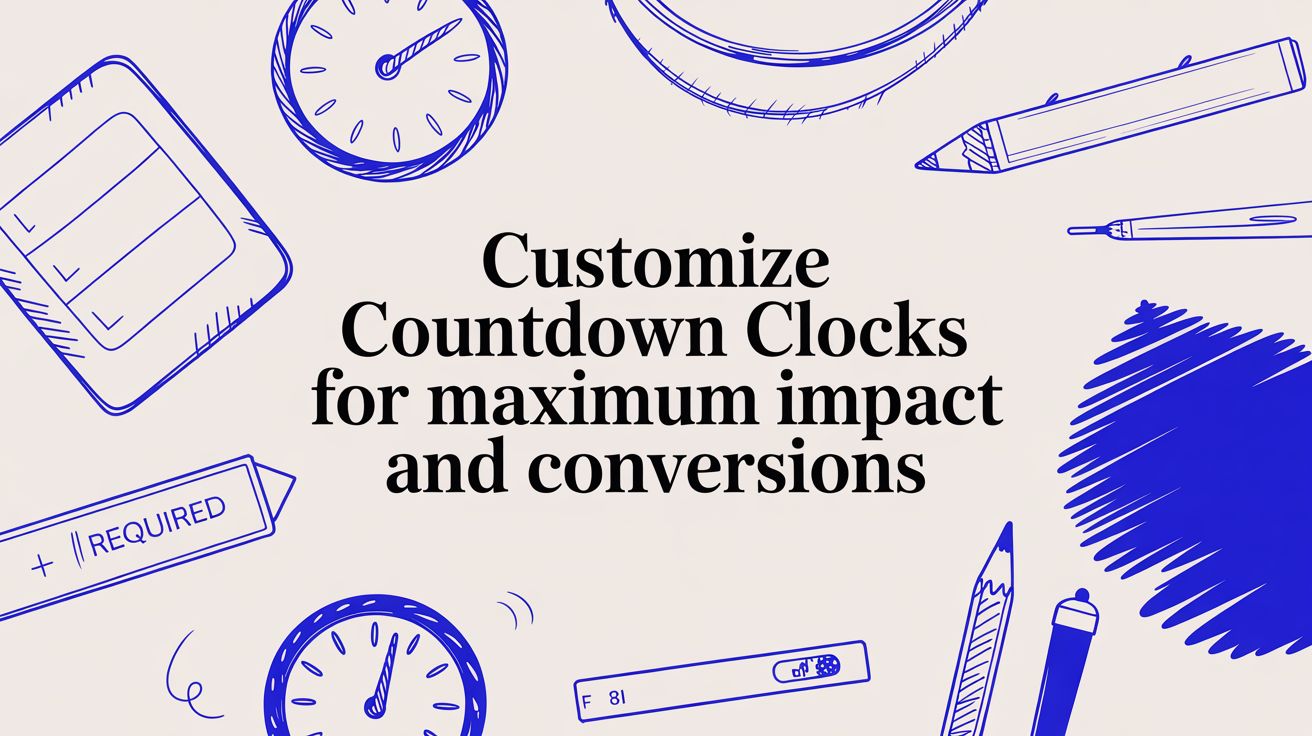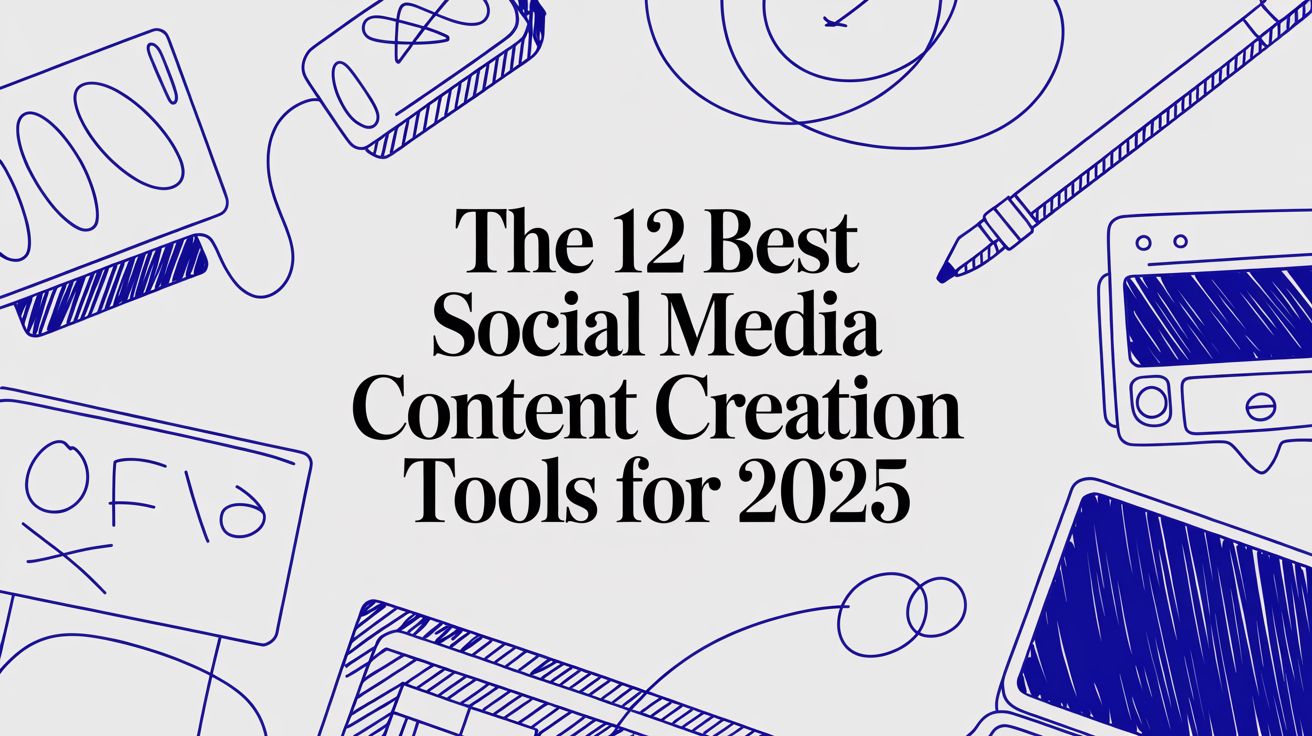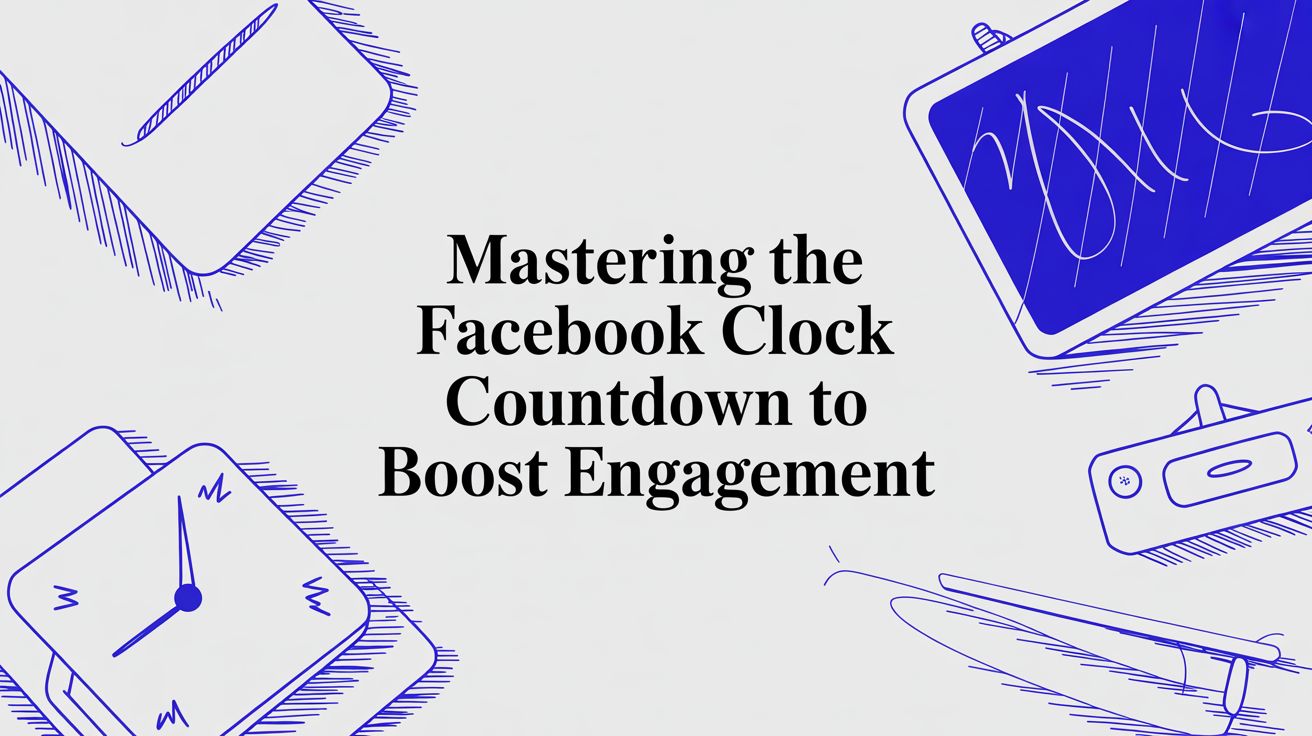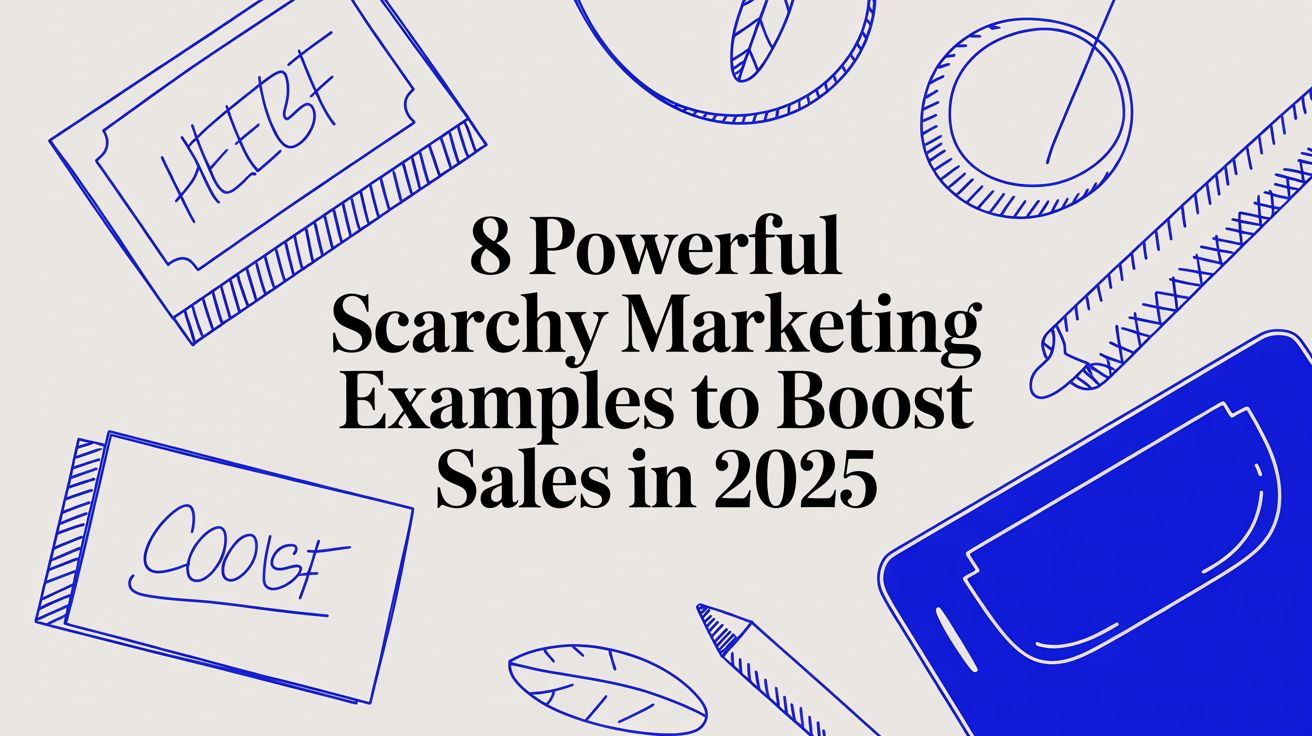10 Social Media Marketing Best Practices for 2025
Unlock growth with these 10 social media marketing best practices for 2025. Master strategy, engagement, and analytics with actionable tips and examples.
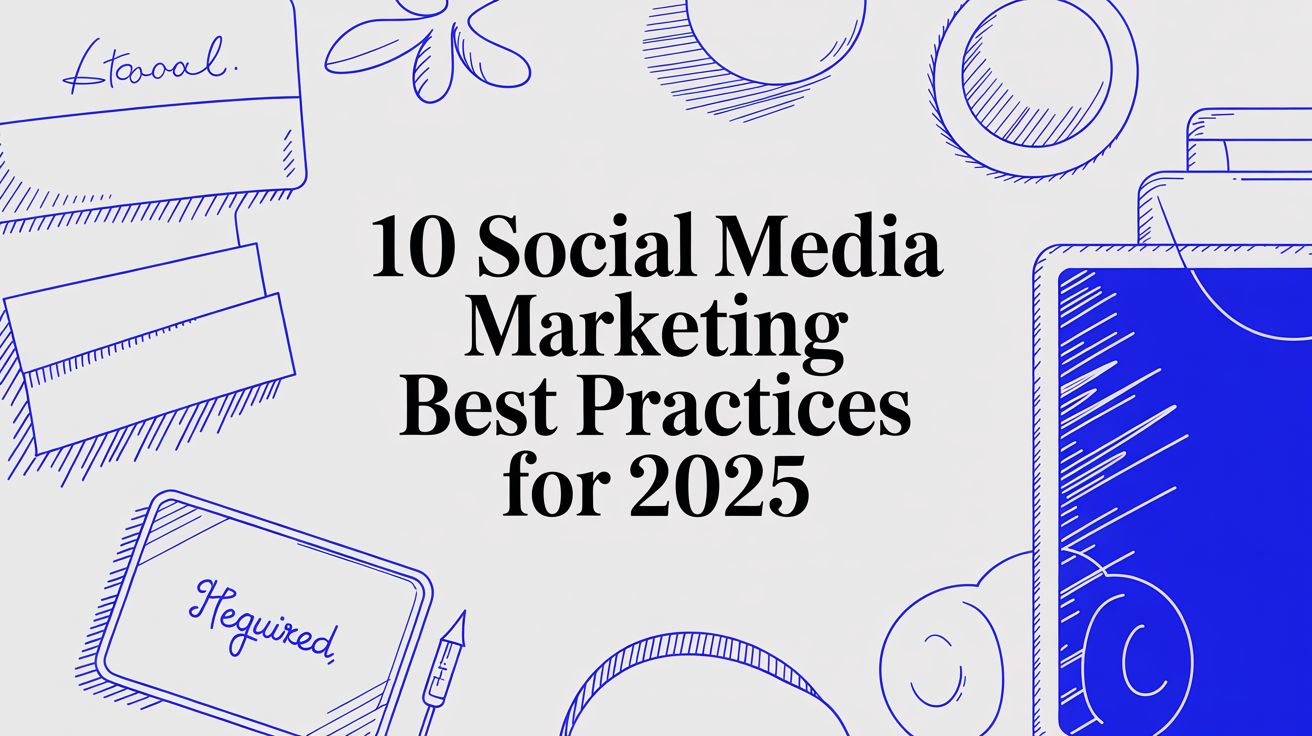
In a digital landscape where attention is the ultimate currency, simply having a social media presence is no longer enough. To truly stand out, brands must move beyond generic advice and adopt strategies that build genuine connections, drive measurable results, and adapt to an ever-changing algorithmic environment. This guide dives deep into 10 proven social media marketing best practices that separate the signal from the noise. We'll explore actionable tactics for everything from crafting a data-driven content strategy to fostering authentic community engagement.
Whether you're looking to refine your current approach or build a new one from the ground up, these insights will equip you with the tools to not just participate in the conversation, but to lead it. We will cover critical topics like optimizing content for each specific platform, developing a powerful hashtag strategy, and authentically connecting with your audience through storytelling. To truly master your social media presence in a crowded digital world, consider adopting effective video marketing strategies for social media alongside the comprehensive practices outlined here.
This list is designed for immediate implementation, offering clear steps for small businesses, marketing agencies, and social media managers alike. Forget vague tips and surface-level insights. Instead, you'll find a detailed roadmap covering everything from leveraging user-generated content and running targeted ad campaigns to building influential partnerships. Each point is structured to provide the "how" and "why," empowering you to create a social media presence that not only captures attention but also drives meaningful business growth. Let's get started.
1. Consistent Posting Schedule
Maintaining a consistent posting schedule means establishing and following a regular cadence for your social media content. This strategy keeps audiences engaged, builds trust, and signals reliability to platform algorithms.

Consistency signals reliability to both followers and algorithms, boosting reach and engagement over time.
What and How It Works
A consistent posting schedule involves planning content in advance and publishing at set intervals. Using tools like Hootsuite or Buffer, you queue posts for peak engagement slots based on analytics.
Benefits of Consistency
- Improved algorithmic reach: Regular updates tell platforms your profile is active
- Higher audience retention: Followers know when to expect new content
- Streamlined workflow: Batch creation saves time and reduces stress
- Balanced content mix: Planning avoids last-minute repetition or gaps
Real-world Examples
- Hootsuite posts 3-5 times daily across Facebook, Instagram, and LinkedIn
- Buffer maintains tailored schedules for audiences in multiple time zones
- Nike shares one Instagram post daily at 11am local time, synced to global launches
Actionable Tips
- Use social media scheduling tools (Buffer, Later, Hootsuite) for queuing posts
- Analyze platform analytics weekly to identify 2-3 peak engagement windows
- Create a content calendar 4-8 weeks ahead to map themes and formats
- Batch photo and video shoots on a single day for consistent style
- Build in “real-time” slots to share trending topics or user-generated content
When and Why to Use This Approach
Adopt a consistent schedule when growth plateaus or engagement dips. Reliability builds brand authority and keeps your social media marketing best practices aligned with audience expectations.
2. Audience Engagement and Community Management
Audience engagement and community management involves actively responding to comments, messages, and mentions to foster meaningful conversations. This proactive approach turns passive followers into an active community, building brand loyalty and signaling to algorithms that your content is generating valuable interactions.

Active engagement transforms your social media presence from a broadcast channel into a dynamic community hub.
What and How It Works
This practice goes beyond simply posting content. It requires monitoring brand mentions, responding promptly to inquiries and feedback, and initiating conversations. It means treating your social media platforms as a two-way communication street where every follower feels heard and valued, ultimately strengthening brand-customer relationships.
Benefits of Engagement
- Increased brand loyalty: Acknowledging followers makes them feel valued and connected.
- Improved algorithm performance: High engagement rates (likes, comments, shares) boost content visibility.
- Valuable audience insights: Direct conversations provide unfiltered feedback on products and services.
- Enhanced brand reputation: Swift and professional responses to feedback build trust and credibility.
Real-world Examples
- Wendy's uses witty, personalized Twitter replies to engage with followers and other brands, creating viral moments.
- GoPro regularly features user-generated content, tagging creators and responding to comments to build a community of brand advocates.
- Glossier cultivates a highly responsive Instagram community, answering product questions and engaging with user posts to create an inclusive feel.
Actionable Tips
- Set a response time goal for all inquiries, aiming for under two hours to show attentiveness.
- Use social listening tools like Sprout Social or Brand24 to monitor untagged brand mentions.
- Create templates for common questions but always personalize the response to the specific user.
- Feature and celebrate user-generated content to make your community feel like part of the brand story.
- Handle negative feedback professionally in public before moving the conversation to a private channel.
When and Why to Use This Approach
Implement a dedicated engagement strategy when you want to transition from a follower count to a loyal community. This is one of the most crucial social media marketing best practices for building long-term brand equity and trust. Active community management is essential for service-based businesses, direct-to-consumer brands, and any organization aiming to foster authentic connections. It helps increase organic reach and creates a more vibrant, interactive online presence. To learn more about how engagement can drive organic reach, you can explore resources like this article on using a Facebook countdown to boost visibility.
3. Leverage User-Generated Content (UGC)
Leveraging User-Generated Content (UGC) involves curating and sharing content created by customers and followers on your official brand accounts. This strategy builds authentic social proof, reduces your content creation workload, and significantly increases audience trust and engagement.

UGC acts as authentic word-of-mouth marketing, turning satisfied customers into powerful brand advocates.
What and How It Works
UGC works by encouraging your audience to create and share photos, videos, or reviews featuring your products or brand. This is typically done through branded hashtag campaigns, contests, or simple call-to-actions, which you then repost, giving credit to the original creator.
Benefits of UGC
- Increased authenticity and trust: Content from real customers is more credible than branded posts.
- Higher engagement rates: Audiences are more likely to interact with content from their peers.
- Cost-effective content creation: Reduces the need for expensive, professional photo and video shoots.
- Community building: Fosters a strong sense of community around your brand.
Real-world Examples
- GoPro's #GoPro campaign encourages users to submit their best action shots, providing an endless stream of high-quality content.
- Starbucks' #RedCupContest turns a seasonal product into a viral social media event driven entirely by customer creativity.
- Adobe's #Adobe_Perspective showcases stunning digital art from its community, highlighting the power of its software.
Actionable Tips
- Create a simple, memorable, and unique branded hashtag for submissions.
- Clearly state the rules and how to participate in your social media bio and posts.
- Always ask for permission before reposting and credit the original creator in the caption.
- Offer incentives like prizes, discounts, or a feature on your main account to boost participation.
- To effectively scale your user-generated content into impactful advertising campaigns, consider exploring a tool like a UGC ad generator.
When and Why to Use This Approach
Incorporate UGC when you need to build social proof, increase brand trust, or diversify your content feed with authentic perspectives. It is a cornerstone of modern social media marketing best practices, ideal for brands wanting to create an active and engaged community rather than just a passive audience.
4. Data-Driven Content Strategy Using Analytics
A data-driven content strategy involves making decisions based on platform analytics, audience insights, and performance metrics rather than assumptions. This practice shifts your approach from guessing what works to knowing what works, allowing for continuous optimization and improved ROI.
Using analytics removes subjectivity from content creation, ensuring every post serves a strategic purpose aligned with business goals.
What and How It Works
This strategy centers on tracking Key Performance Indicators (KPIs) to understand what content resonates with your audience. By analyzing metrics like engagement, reach, and click-through rates, you can identify patterns in successful posts and replicate them. Tools like Sprout Social or native platform analytics provide the data needed to refine your content mix, posting times, and messaging.
Benefits of a Data-Driven Strategy
- Higher engagement: Content is tailored to proven audience preferences
- Improved ROI: Resources are invested in content formats that deliver results
- Enhanced audience understanding: Deep insights into demographics and behavior
- Strategic agility: Quickly adapt to changing trends and algorithm updates
Real-world Examples
- Netflix analyzes viewer data on what content is watched and shared to inform its original programming and promotional campaigns.
- Spotify uses listener analytics to curate personalized playlists like "Discover Weekly," boosting user retention and platform engagement.
- The New York Times A/B tests headlines on social media to see which version generates the most clicks, maximizing article traffic.
Actionable Tips
- Use native tools first, such as Instagram Insights or Facebook Analytics, for accessible data
- Set up dashboards to track core KPIs: engagement rate, reach, click-through rate (CTR), and conversions
- Review analytics weekly to spot short-term trends and compile monthly reports for a broader strategic overview
- Compare performance across different content types (e.g., video vs. carousel) to identify top formats
- A/B test one variable at a time, such as caption length or CTA, to isolate what drives results
When and Why to Use This Approach
Implement a data-driven strategy when your content performance feels inconsistent or you want to scale your results more predictably. This is one of the most critical social media marketing best practices for moving beyond vanity metrics and connecting your social media efforts directly to measurable business objectives like lead generation and sales.
5. Platform-Specific Content Optimization
Platform-specific content optimization means tailoring your message, format, and tone to the unique audience expectations and algorithmic rules of each social media channel. Instead of cross-posting the same content everywhere, this approach adapts your core idea to fit the native environment of platforms like LinkedIn, TikTok, or Instagram.
A one-size-fits-all approach to content dilutes your message; optimizing for each platform maximizes relevance and impact.
What and How It Works
This practice involves creating distinct versions of your content for different channels. For example, a single product launch could become a polished, professional article on LinkedIn, a visually striking carousel on Instagram, a quick, entertaining video on TikTok using a trending sound, and a conversational thread on X (formerly Twitter).
Benefits of Optimization
- Increased engagement: Content that feels native to a platform performs better.
- Improved algorithmic visibility: Platforms reward the use of their specific features.
- Stronger audience connection: Followers appreciate content that respects the platform's culture.
- Higher conversion rates: Tailored messaging resonates more deeply and drives action.
Real-world Examples
- Wendy's uses a witty, sarcastic tone on X for real-time engagement, while its Instagram focuses on high-quality food imagery.
- Gary Vaynerchuk repurposes one long-form video into dozens of platform-specific clips, quotes, and articles for YouTube, LinkedIn, and Instagram.
- HubSpot shares in-depth marketing reports on LinkedIn but uses short, educational Reels to explain the same concepts on Instagram.
Actionable Tips
- Adjust video lengths: Aim for 5-10 minutes on YouTube, 30-90 seconds for Instagram Reels, and 15-60 seconds on TikTok.
- Vary hashtag usage: Use 15-25 on Instagram for discovery, 3-5 professional tags on LinkedIn, and just 1-2 on X for context.
- Adapt your tone: Keep it professional and insightful on LinkedIn, aesthetic and inspiring on Instagram, and casual or humorous on TikTok.
- Use native features: Leverage Instagram Stories, LinkedIn Polls, or TikTok Duets to boost visibility. To learn more about using platform-specific features, you can promote events with native tools on countdown-timer.app.
When and Why to Use This Approach
Implement platform-specific optimization immediately to elevate your social media marketing best practices. It is crucial when you notice engagement is high on one platform but low on others, as it indicates a mismatch between your content and the audience's expectations. This strategy ensures every piece of content is positioned for maximum success.
6. Influencer and Partnership Collaborations
Partnering with influencers, micro-influencers, or complementary brands expands your reach and builds credibility through trusted, third-party endorsements. This approach leverages an established audience's trust to introduce your products or services authentically.
Collaborations lend your brand instant social proof, borrowing credibility from creators who have already earned their audience's trust.
What and How It Works
Influencer marketing involves collaborating with content creators who have a dedicated following. Brands provide products, services, or payment in exchange for mentions, reviews, or co-created content shared with the influencer’s audience, driving awareness and sales.
Benefits of Collaborations
- Expanded reach: Access new, relevant, and engaged audiences instantly.
- Enhanced credibility: Endorsements from trusted voices build consumer confidence.
- High-quality content: Gain authentic, user-centric content for your own channels.
- Improved ROI: Micro-influencers often deliver higher engagement rates at a lower cost.
Real-world Examples
- Daniel Wellington built its empire by gifting watches to a massive network of micro-influencers who shared posts with unique discount codes.
- Fashion Nova partners with thousands of micro-influencers and celebrities, flooding Instagram feeds with brand-aligned content daily.
- Sephora runs its #SephoraSquad ambassador program, creating long-term relationships with a diverse group of beauty creators.
Actionable Tips
- Start with micro-influencers (10K-100K followers) for better engagement and ROI.
- Use platforms like HypeAuditor or AspireIQ to vet influencers for authentic engagement and audience demographics.
- Prioritize audience alignment over sheer follower count to ensure relevance.
- Create clear campaign briefs but allow for creative freedom to maintain authenticity.
- Track performance with unique discount codes or affiliate links to measure direct impact.
- Build long-term relationships for more genuine and sustained brand advocacy.
When and Why to Use This Approach
Implement influencer collaborations when you need to quickly build brand awareness, enter a new market, or generate social proof for a product launch. This social media marketing best practice is highly effective for driving both top-of-funnel awareness and bottom-of-funnel conversions.
7. Strategic Use of Video Content
Prioritizing video as a primary content format is no longer optional; it’s a core component of modern social media strategy. This involves creating and distributing everything from short-form clips on TikTok and Reels to in-depth videos on YouTube, capitalizing on video’s superior engagement rates and favorable algorithmic treatment.
Video captures attention more effectively than any other medium, making it a powerful tool for storytelling and driving audience action.
What and How It Works
A strategic approach to video content means aligning video production with specific marketing goals, whether that’s brand awareness, lead generation, or direct sales. It involves identifying the formats that resonate with your target audience and consistently producing high-quality content tailored for platforms like TikTok, Instagram, and YouTube, where video is the dominant format.
Benefits of Video Content
- Higher engagement rates: Video consistently generates more likes, comments, and shares
- Increased algorithmic priority: Platforms like Instagram and Facebook reward video with greater reach
- Improved audience connection: Video conveys emotion and personality more effectively than text or images
- Versatile storytelling: Formats range from quick explainers to long-form documentaries
Real-world Examples
- Crazy Egg uses short, animated explainer videos on YouTube to break down complex analytics concepts, driving traffic and establishing authority.
- Tesla shares behind-the-scenes factory footage and product demonstrations on YouTube, building transparency and brand loyalty.
- TikTok creators leverage trending sounds and challenges to achieve viral reach almost overnight, showcasing the power of short-form video.
Actionable Tips
- Hook viewers within the first three seconds to prevent them from scrolling past
- Add captions, as over 80% of users watch videos with the sound off
- Keep short-form videos under 60 seconds; 15-30 seconds is often the sweet spot
- Use storytelling techniques with a clear beginning, middle, and end, even in short clips
- Repurpose longer videos by clipping highlights for platforms like Reels and Shorts
When and Why to Use This Approach
Integrate a video-first strategy when you need to boost engagement, explain a complex product, or build a stronger human connection with your audience. Given that all major social platforms are now prioritizing video, incorporating this format is essential for any brand looking to stay relevant and competitive in their social media marketing best practices.
8. Paid Social Media Advertising and Retargeting
Paid social media advertising involves strategically allocating a budget to promote content on platforms like Facebook, Instagram, and LinkedIn. It is often combined with retargeting, a powerful tactic that serves ads to users who have previously interacted with your brand, such as visiting your website or engaging with a post.
Paid advertising accelerates reach and conversions, while retargeting ensures your marketing message connects with an already-warm audience most likely to act.
What and How It Works
This practice uses platform tools like Facebook Ads Manager to define target audiences based on demographics, interests, and behaviors. By installing a tracking pixel on your website, you can build custom audiences of past visitors and serve them specific ads, guiding them further down the sales funnel.
Benefits of Paid Social and Retargeting
- Hyper-targeted reach: Connect with niche audiences beyond your organic followers.
- Higher conversion rates: Retargeting warm leads often yields a much higher ROI.
- Accelerated growth: Quickly scale brand awareness, lead generation, or sales.
- Measurable performance: Ad platforms provide detailed analytics to track spending and results.
Real-world Examples
- Dropbox famously achieved a 1000% ROI by using retargeting ads to re-engage users who had started but not completed the sign-up process.
- E-commerce brands routinely recover 30-40% of abandoned carts by serving product-specific ads to shoppers who left their site.
- SaaS companies leverage LinkedIn ads to target professionals by job title, industry, and company size for effective B2B lead generation.
Actionable Tips
- Install platform pixels (e.g., Meta Pixel, LinkedIn Insight Tag) before launching campaigns.
- Create custom audiences from website visitors, email lists, and app users.
- Design specific landing pages for each ad campaign to ensure a consistent user journey.
- Use sequential messaging to show different ads to users at various stages of awareness.
- To create a sense of urgency in your ads, you can learn more about adding a countdown timer to a Facebook ad.
- A/B test ad creative, headlines, and calls-to-action (CTAs) to identify top performers.
When and Why to Use This Approach
Implement paid advertising and retargeting when organic reach stagnates or when you need to drive specific, time-sensitive actions like event registrations, product launches, or sales. This is one of the most effective social media marketing best practices for converting interested prospects into paying customers.
9. Authentic Storytelling and Brand Voice
Authentic storytelling means developing and consistently using a unique brand voice to share genuine narratives, values, and behind-the-scenes content. This practice builds deep emotional connections that transcend simple product promotion, turning followers into loyal brand advocates.
An authentic voice humanizes your brand, building trust and community by showing followers the real people and values behind the logo.
What and How It Works
This approach involves defining your brand's core mission, values, and personality, then translating them into a consistent tone and style for all social media communication. Instead of just selling, you share the "why" behind your business, including founder stories, employee spotlights, and even transparent accounts of challenges.
Benefits of Authenticity
- Deeper audience connection: Stories create an emotional bond that sales pitches cannot
- Increased brand loyalty: Followers connect with values, not just products
- Improved differentiation: A unique voice makes your brand memorable in a crowded market
- Higher engagement: Genuine content encourages more meaningful interactions and shares
Real-world Examples
- Patagonia shares stories of environmental activism, aligning its content with its core mission to save our home planet
- Ben & Jerry's consistently uses its platform to advocate for social and racial justice, reinforcing its progressive brand identity
- Tony's Chocolonely is radically transparent about its mission to end slavery in the chocolate industry, sharing supply chain stories
Actionable Tips
- Define and document your brand mission, values, and personality first
- Create a brand voice guide with approved terminology, tone, and style
- Share founder stories, team backgrounds, and "day in the life" content
- Showcase behind-the-scenes glimpses of your processes, culture, and even failures
- Feature real customers and employees as brand storytellers
- Tell stories that illustrate your values in action, not just stating them
- Respond to community comments and issues with a consistent, human tone
When and Why to Use This Approach
Implement authentic storytelling when you need to differentiate your brand beyond price or features. It is a core component of modern social media marketing best practices because it builds long-term trust and community, which are far more valuable than short-term transactional engagement. This strategy is essential for brands aiming to foster a loyal following that connects with their purpose.
10. Hashtag Strategy and Search Optimization
A well-researched hashtag strategy involves selecting and using relevant hashtags to improve content discoverability, connect with niche audiences, and join trending conversations. It transforms your posts from isolated updates into searchable assets that attract a targeted, high-intent audience.
A thoughtful hashtag strategy is one of the most effective organic tools for expanding reach beyond your current followers.
What and How It Works
This social media marketing best practice treats hashtags as keywords for social search engines. By combining branded, community, and trending tags, you categorize your content, making it easier for users interested in those topics to find you. The process involves researching popular and niche tags, analyzing competitor usage, and applying a balanced mix to each post.
Benefits of Hashtag Strategy
- Increased visibility: Content appears in hashtag feeds and search results
- Targeted audience growth: Attracts users already interested in your niche
- Enhanced brand association: A unique branded hashtag builds community
- Improved engagement rates: Reaching relevant users leads to more likes and comments
Real-world Examples
- Starbucks' #RedCupContest: Annually generates millions of user-generated photos, driving massive brand engagement.
- Airbnb's #BelongAnywhere: Effectively communicates its brand mission and connects a global community of travelers.
- Twitter's #MeToo: Sparked a global movement, demonstrating how a single hashtag can amplify a conversation to an unprecedented scale.
Actionable Tips
- Use hashtag research tools like RiteTag or Hashtagify to find relevant and trending tags.
- Apply the 70/20/10 rule: 70% niche-specific, 20% broad/popular, and 10% branded hashtags.
- Customize hashtag count per platform: aim for 20-30 on Instagram, 1-2 on Twitter, and 3-5 on LinkedIn.
- Place Instagram hashtags directly in the caption, as the algorithm prioritizes them over those in the first comment.
- Create and consistently track a unique branded hashtag to monitor user-generated content and brand sentiment.
- Rotate your frequently used hashtags to avoid being flagged as spam by platform algorithms.
When and Why to Use This Approach
Implement a formal hashtag strategy when you need to accelerate organic reach or break into a new audience segment. It is essential for brands looking to build a community, run user-generated content campaigns, or increase their visibility in specific interest-based conversations. This tactic is fundamental to any robust social media marketing plan.
Top 10 Social Media Marketing Best Practices Comparison
| Strategy | Implementation Complexity 🔄 | Resource Requirements ⚡ | Expected Outcomes 📊⭐ | Ideal Use Cases 💡 | Key Advantages ⭐ | |---|---:|---:|---|---|---| | Consistent Posting Schedule | Moderate — repeatable process, requires planning | Moderate — content creation time + scheduling tools | 📊 Steady reach & engagement; ⭐ better algorithmic visibility | Brands needing steady presence, follower growth | ⭐ Predictable cadence; builds audience habits | | Audience Engagement & Community Management | High — real‑time responses and moderation | High — trained staff, social listening tools | 📊 Stronger loyalty & advocacy; ⭐ improved customer perception | Customer service, community-driven brands | ⭐ Deep relationships; actionable feedback | | Leverage User‑Generated Content (UGC) | Moderate — campaign setup + curation/moderation | Moderate — incentives, rights management, moderation | 📊 Higher engagement (3–5x); ⭐ authentic social proof | Consumer brands, UGC campaigns, contests | ⭐ Cost-effective content; increased trust | | Data‑Driven Content Strategy Using Analytics | High — requires analytics workflows and testing | High — analytics tools + analyst time | 📊 Optimized performance & ROI; ⭐ data-informed decisions | Performance-focused teams, scaling efforts | ⭐ Removes guesswork; measurable improvement | | Platform‑Specific Content Optimization | High — tailor formats, tone, and specs per channel | High — extra production and platform expertise | 📊 Better platform engagement & conversion; ⭐ improved relevance | Multi‑platform distribution, niche audiences | ⭐ Maximizes per‑platform performance | | Influencer & Partnership Collaborations | Moderate — vetting, contracts, coordination | Variable — depends on influencer tier and fees | 📊 Expanded reach & credibility; ⭐ higher conversion potential | Product launches, audience expansion campaigns | ⭐ Access to engaged audiences; social proof | | Strategic Use of Video Content | Moderate–High — production and editing cycles | High — equipment, editing skills, time | 📊 Very high engagement & shareability; ⭐ strong conversions | Tutorials, storytelling, product demos | ⭐ Top engagement format; algorithm preference | | Paid Social Media Advertising & Retargeting | Moderate — campaign setup + continuous optimization | High — ad spend, tracking pixels, campaign managers | 📊 Targeted reach & measurable conversions; ⭐ scalable ROI | Lead gen, e‑commerce, performance campaigns | ⭐ Precision targeting; quick scalable results | | Authentic Storytelling & Brand Voice | Moderate — consistent narrative and editorial control | Moderate — creative time, editorial oversight | 📊 Deeper loyalty & brand differentiation; ⭐ long‑term advocacy | Mission‑driven brands, retention-focused strategies | ⭐ Emotional connection; attracts like‑minded customers | | Hashtag Strategy & Search Optimization | Low–Moderate — research and monitoring | Low — research tools and testing time | 📊 Improved discoverability; ⭐ reach beyond followers (variable) | Awareness drives, UGC amplification, trend participation | ⭐ Low‑cost discoverability; organizes content around themes |
Turning Best Practices into Powerful Performance
Navigating the dynamic world of social media requires more than just a passing knowledge of what works. It demands consistent, strategic action. The journey from simply being present on social platforms to truly commanding an engaged and loyal audience is built on the deliberate application of the principles we've explored. These are not just items on a checklist; they are the fundamental pillars of a resilient and impactful digital strategy.
The true value of these social media marketing best practices emerges when they are woven together into a cohesive system. A consistent posting schedule (#1) is the foundation, but it's the authentic brand voice (#9) and compelling storytelling that give your content life. Likewise, a data-driven content strategy (#4) tells you what resonates, while deep audience engagement (#2) transforms passive viewers into a vibrant community. Each practice amplifies the others, creating a powerful synergy that drives measurable results.
From Knowledge to Action: Your Implementation Roadmap
Understanding these concepts is the first step, but implementation is what separates successful brands from the rest. To avoid feeling overwhelmed, focus on an iterative approach. You don't need to master all ten practices overnight.
Instead, start by focusing on two or three key areas that align with your immediate goals:
- If your engagement is low: Prioritize Audience Engagement and Community Management and leveraging User-Generated Content (UGC). Actively start conversations, respond to every comment, and create a campaign encouraging followers to share their experiences with your brand.
- If your content feels stale: Dive into Strategic Use of Video Content and Platform-Specific Content Optimization. Experiment with Reels or TikToks, and ensure your content is natively tailored to the unique formats of each channel, rather than just cross-posting.
- If your reach has plateaued: It's time to explore Paid Social Media Advertising and Influencer and Partnership Collaborations. A small, targeted ad budget can significantly expand your audience, while a strategic partnership can introduce your brand to an entirely new, relevant community.
The key is to plan, execute, analyze, and refine. Use your analytics to track the impact of your new focus. Did your engagement rate increase after you started responding to all comments? Did your video content get more shares than static images? Let the data guide your next steps, allowing you to build momentum and progressively integrate more of these best practices into your daily workflow.
The Lasting Impact of a Strategic Approach
Mastering these social media marketing best practices is about more than just boosting vanity metrics. It's about building tangible business assets: brand equity, customer loyalty, and a direct line of communication with the people who matter most to your success. By moving beyond random acts of posting and adopting a structured, strategic framework, you transform your social media channels from a simple marketing outpost into a powerful engine for growth, connection, and conversion. The effort you invest in applying these principles consistently will pay dividends, creating a robust digital presence that not only captures attention but also drives meaningful business outcomes.
Ready to supercharge your engagement for key events? Create urgency and excitement for your next product launch, sale, or live stream with Countdown Timer App. Add a live, auto-updating countdown timer directly to your Facebook page or share it anywhere online to keep your most important moments top-of-mind for your audience. Start building anticipation today at Countdown Timer App.

